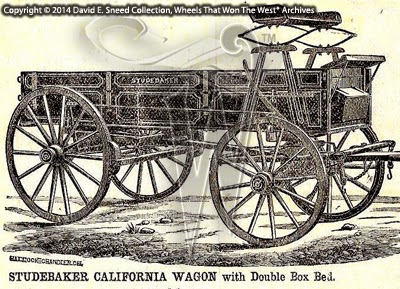As a western vehicle historian, I’mconstantly digging for more information on early wooden wheels used in the West. I look for details about the piecesthemselves, their specific uses, unique designs, individual builders, marketingmethods, competitive strategies, and the overall industry. All of it helps us gain a clearer and betterpicture of the complexities of America’s first transportation empire.
Not long ago, I stumbled upon an 1882article sharing some of the challenges faced by heavy vehicle builders inCalifornia. The frustrations of thewriter are clear as he repeatedly laments the lack of large capacity wagon makersin the Bear State.
Clearly, there were notable, nativebuilders in California during the 1880’s. However, at least during the time of this article, none had sufficientlygrown to compete in mass scale with well-known manufacturers in the Midwest andEast. Below are several excerpts fromthe article. As you’ll see, the commentsbegin with an optimistic outlook on the number of vehicles used throughoutCalifornia. The tone quickly changes,though, as the writer pinpoints significant issues faced by builders.
“... The high rateof wages, the value of time to business men, the abundance and cheapness ofhorses and horse feed, the sparseness of population, the long distances atwhich many of the farmers live from towns, the number of good roads, and theconsiderable amounts of exports and imports, have led the people of our coastto own and use an exceptionally large number of wagons and buggies. It is doubtful whether so many are to befound in proportion to the people in any other part of the world. All the large towns have pleasure drives, onwhich the light buggy and the fast trotter are leading features.
While we consumea great number of wheeled vehicles, we produce but few. The oak used in the heavy and the hickory inthe light wagons are equally lacking, and we must import both from theMississippi Valley, and it is found cheaper to obtain them for general use informs prepared for putting together, if not already put together in the variousparts of wagons. A great part of thevalue of a wagon is in the wheels, most of which are made up for us beyond theRocky Mountains. Even when wagons aremade here, the spokes, felloes, hubs, axles, and tongues have not infrequentlybeen shaped in the East. We purchase onthis coast about 7,000 farm wagons annually, worth $100 each, and the numbermade here is very small, not one factory or shop being devoted exclusively totheir production. Nor until we grow somewood that can rival the Eastern white oak in strength, elasticity, and evenhardness of grain, is it probable that we can establish large factories forfarm wagons with profit, even if the difference of 25% in wages against ourmanufacturers should be removed….”
The writer continues by sharing that themining communities also seemed to be overly dependent upon vehicles createdthousands of miles away.
“…The buildingof railroads and the decrease of production and population in the placer miningcamps, deprived these mountain teamsters of much of their business, anddiminished the demand for wagons of special patterns. The freight is now carried in vehiclesbrought from Michigan…”
The reference to Michigan-builtfreighters is particularly interesting. Beyondthe distance from California, the notation is intriguing because part of early vehicle identification involves not only intimate knowledge of how a particularbrand was built but, also awareness as to where those sets of wheels were distributed. By pointing to the state of Michigan, thereis a strong probability that the legendary Jackson brand of wagons were theones referred to as hauling freight to and from the mining camps. These freighters were often described as‘Michigan wagons’ throughout the 19th century. It’s an important clue and one that bears remembrance during careful evaluationsof surviving western freighters of unknown origins. Time and again, period writings proclaim theprominence of Jackson freight wagons (Austin, Tomlinson, & Webster Company). Yet, like a number of other legendary wagonmakers, we know of no Jackson freighters to have positively been identified todate.
 |
| This 1889 Jackson wagon catalog contains a wealth of information on numerous Jackson vehicles – including freighters. |
With so much of America’s early wheeledhistory lost or forgotten, it takes time and patience to uncover valuablepieces and put them back together again. Perhaps, through the sharing of some of these findings, we may yetrestore important identities to vehicles that have been separated from theirroots. The early Jackson catalogs andreference works in our Archives may one day help return a legend to its placein history. For your part, if you findyourself traveling in the West, take plenty of photos of any early freighters(large and small) you come across. We’dlove to see them and compare to documents in our care. Together, just maybe, we can help return someof the West’s most important and least known history to its rightful place.
